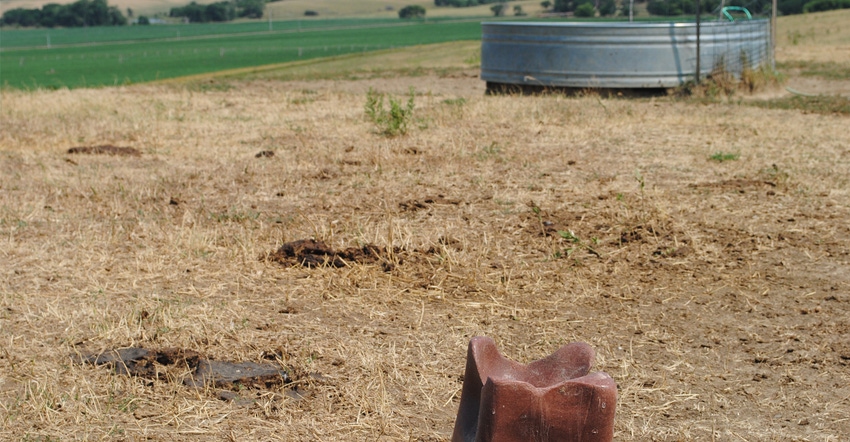
The drought in 2021 reached disastrous levels for central North Dakota, wreaking havoc on farmers, ranchers and their land. One such rancher was Shane Anderson of Towner, who has been ranching on his family land for nearly 20 years, building his own herd of commercial cattle, only to be forced to scale back his herd.
“It was a multitude of things. But just knowing in the back of my mind that we had not had any moisture” in spring, “I didn’t want to get to a place where I was trying to move pairs in the middle of summer,” Anderson says, of making the decision to sell cattle last year.
In an average year, his ranch runs 300 to 350 head. During 2021’s drought, he sold over 100 head.
“When we were in the middle of breeding season, it looked like our hay crop was already going to be adversely affected. I felt better making the decisions to move that many animals, knowing that if it started to rain, I would be able to graze more acres later or do something with that grass,” he says. “If I didn’t think this through, then every decision I made from there on out would probably be a knee-jerk reaction and maybe wouldn’t be the best option.”
Cull time?
Drought conditions last year forced some ranchers, like Anderson, to make tough decisions, including selling off cattle due to potential lessened forage, pastures and rangeland. But how do cattle producers decide which cows get sent down the road and when?
Olivia Amundson, a cow-calf field specialist with South Dakota State University Extension, spearheaded a cull cow survey, completed Dec. 1, to get a pulse on issues concerning culling, and how much impact drought had on those decisions.
Cattle producers from South Dakota, North Dakota, Montana, Minnesota, Iowa, Colorado and Wyoming rank the main reasons for culling cows during a normal year, in order of importance:
open cows
temperament
health
age
“Then I asked, ‘On a dry year with low forage resources, how do you cull your cows?’ What was the most important then?” Amundson asks. The same four cull reasons surfaced during a dry year, but age came in as the third most important reason, while health came in fourth.
“Definitely noticing an increase in dispersals coming into the bred cow sales this year,” says Kiernan Brandt, SDSU Extension cow-calf field specialist. “You can definitely tell that the increase in feed prices is driving some folks to bring some additional bred cows to sale, but they’re holding their value from what I’m able to tell.”
With the thinking to plan for a bad year, but hope for a good year, Amundson says some producers bred their cows with the hopes of keeping them in the herd, but if forced to sell, a bred cow may have more value.
“I think a lot of guys, especially on the western part of the state, are pretty quick to pull that trigger early in the year and say, ‘We’re dry. We’re going to make cuts early,’” Brandt says, adding he believes many producers drew an age line in the sand.
“I think some guys just did full dispersal of everything over 8 years old,” he says. “For me, being someone who focuses a lot on the genetics side, I’m not super-pleased that guys are making deeper cuts and not taking closer looks at udder quality and feet and leg structure and performance.”
Amundson agrees. “Cows that calf earlier in the calving season remain in the herd longer. And when that happens, a lot of times they end up weaning more pounds of calves in their overall lifetime, and they end up paying for themselves. Why get rid of them if they’re continuing to get pregnant? They’re really profiting the operation.”
A University of Nebraska-Lincoln publication offers research on females remaining in the herd to produce more pounds of weaned calves over their lifetime.
Amundson stresses the importance of record keeping to allow cattle producers to make more educated decisions. Knowledge of a herd’s records and marketing can help ranchers know when and how to pull the trigger on culls.
Beef survey says
The SDSU Extension survey broke down how cattle producers handled cull cows:
79% market them through sales barns
almost 10% directly market them
0.38% feed them to sell to packer for white fat market
Timing can be everything, but Amundson says survey respondents may be missing out on value as 23% say they sell their cows in November and 21% sell in October, both traditionally low markets.
“This is good to know, because I see it as there is room for additional education and opportunities, as well as some applied research on our end,” she says.
When drought comes into play, the survey results show that 67.8% sell their cull cows earlier, while 28.7% didn’t change their selling time.
Amundson sees opportunity to educate cattle producers, as they responded that improving genetics and profitability would help them make better culling decisions.
“I think a lot of producers acknowledge a significant proportion of their income comes from their cull cows,” Brandt says. �“I think there’s a push for guys to start capturing some more quality value out of their animals.”
Capturing that value may be as simple as just changing the way cattle producers market their culls, whether it be through “pursuing premiums for carcass quality through direct marketing, alternative marketing arrangements or through the white fat market when premiums pay,” he says.
Assessing forages
For ranchers like Anderson, drought concerns linger for 2022. The year following a drought year can be tough for forage production for grazing, even with normal precipitation, says Jerry Volesky, Nebraska Extension range and forage specialist. “The reasons are most likely associated with the reduced root and rhizome growth, formation of new buds, and overall energy reserve status of grazing plants,” he says.

It’s hard to predict just how much forages will be reduced, because drought severity, soil moisture conditions and precipitation patterns vary regionally. One way to mitigate this uncertainty is to avoid grazing the same pasture at the same time each year.
“Previous research has shown that repeated annual grazing during the rapid growth stage will reduce the overall vigor of grasses,” he notes. “This rapid growth phase is when grass plants are transitioning from a vegetative to elongation and reproductive stages.”
This period is typically in May for cool-season grasses and during June and July for warm-season species. Combining drought and grazing stress will greatly increase the likelihood of reduced forages in the subsequent year.
After last season’s drought, different precipitation scenarios could play out this season. No matter which scenario comes to fruition, the focus needs to be on balancing forage supply (growth and production) with demand (animal numbers on the grazing lands).
“Keep in mind that grazing management through consecutive drought years is critical for future pasture health,” Volesky says.
Common recommendations include:
delaying initial pasture turnout
reducing stocking rates
capitalizing on growth of weedy species that might occur
using rotational grazing, or in some areas, grazing pastures only once from turnout to a killing frost
using alternative forages to fill in demand
Weather and soil moisture conditions on a few critical dates this spring will help producers decide which recommendations to implement and when to employ them, Volesky says.
Is the drought over?
“I’m not convinced this drought is really over. The moisture we got this fall was wonderful; the snow was great. But long term, I don’t know if we’re completely out of the woods yet,” Anderson says.
North Dakota and South Dakota have received above-average moisture through the winter.
Anderson plans to keep back a few additional pairs from his breeding program this spring but, otherwise, is holding steady for this season. “I’ve sent my replacements [heifers] to a feedlot, and I’m confident I should have the grass to breed them at home this year. We’re maintaining the number of bred cows, and if things really do turn around, we’re going to bank resources and give those pastures a little more time to recuperate,” he says.
McHenry County in North Dakota was one of the places hit worst during the drought, experiencing D4 or exceptional drought May through mid-September, and is still designated to be in a drought by USDA.
“I can’t think of many who weren’t affected here in McHenry County,” Anderson says. “This was the heart of the drought, and it just expanded. From every direction from my closest neighbor to 20 miles away, I can’t think of somebody who didn’t sell something or do something different.”
While herds were culled and cattle sold, Anderson and other ranchers affected by drought are looking forward to better times to rebuild their herds.
“We’re looking to get through the 2022 grazing season as the determining factor of how fast we restock,” Anderson says. “Everyone wants to rebuild with their genetics, but there’s good cattle to choose from found all over the state.”
About the Author(s)
You May Also Like









